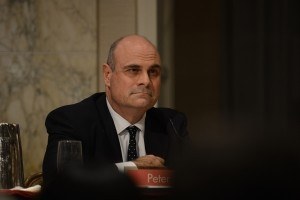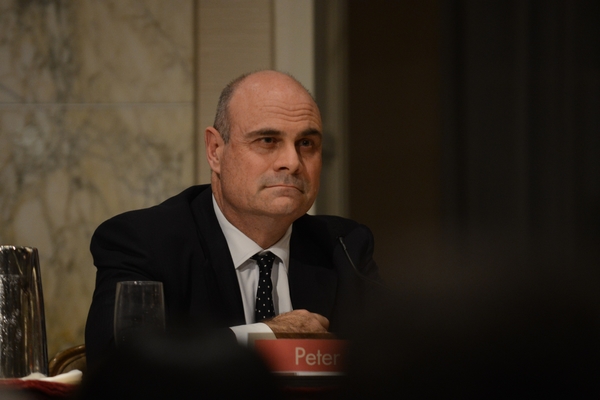When Peter Hancock spoke at the Professional Liability Underwriting Society D&O Symposium in February 2012, he may not have foreseen yesterday’s announcement that he would ascend to the highest executive role at AIG—and take a seat on the company’s board of directors, effective Sept. 1.
Back then, when he was CEO of AIG Property Casualty, Hancock facetiously told a room filled with directors and officers liability insurance underwriters that he would probably never accept an invitation to serve on a corporate board.
Why not?
After leaving a prior position at J.P Morgan in 2000, he recalled, he was recruited to serve on the audit committee for Enron. Fortunately news of Enron’s demise broke faster than he could accept the board position, he said.
“Since then, I have chosen not to sit on any public board,” Hancock said. “I am a wimp.”
No longer wimpy, Hancock said he accepted the responsibility of the entire AIG organization, and a seat on its board, in a media statement on Tuesday.
He also praised the man he will replace—Robert Benmosche.
“In just under five years, Bob transformed AIG’s culture into one that fosters empowerment and tenacity, reinvigorating our employees around the world and enabling them to achieve the impossible,” he said.

(Photo: Don Pollard)
“Today, a far stronger AIG has the opportunity to extend our industry-leading positions as we continue to set new standards of quality for our customers and distribution partners worldwide,” Hancock said. “I look forward to working with our board, our management team, and our exceptionally talented employees and distribution partners to create value for all of our stakeholders.”
Hancock, who currently serves as Executive Vice President, AIG, and Chief Executive Officer of AIG Property Casualty, will take Benmosche’s titles of AIG President and Chief Executive Officer on September 1.
The news comes less than a month after the Wall Street Journal reported that AIG’s board had narrowed its choices for Benmosche’s successor down to Hancock and Jay Wintrob, who leads AIG’s life-insurance and retirement division. And it comes just a day after Hartford Financial Services Group Inc. announced that Christopher Swift would replace Liam McGee as Hartford’s CEO, starting in July.
Benmosche is expected to resign from the board, assuming an advisory role at AIG. In that capacity, he will advise Hancock and continue to be involved in AIG’s internal leadership development programs, as well as mentor and coach AIG managers.
Hancock, 55, joined AIG in 2010 and was named Chief Executive Officer of AIG Property Casualty in March 2011, when the division was reorganized into two major global groups: Commercial and Consumer.
Previously, he had served as Executive Vice President, Finance, Risk, and Investments, AIG.
AIG notes that Hancock has spent his entire career in financial services:
- He spent 20 years at J.P. Morgan, where he established the Global Derivatives Group, ran the Global Fixed Income business and Global Credit portfolio, and served as the firm’s Chief Financial Officer and Chief Risk Officer.
- He co-founded and served as President of Integrated Finance Limited, an advisory firm specializing in strategic risk management, asset management, and innovative pension solutions.
- He joined AIG from KeyCorp, where he was Vice Chairman, responsible for Key National Banking.
Hancock is also a member of the Board of the Japan Society and a member of the International Advisory Board of BritishAmerican Business.
Raised in Hong Kong, Hancock later attended Oxford University, where he earned his Bachelor of Arts degree in politics, philosophy, and economics.
He is a William Pitt Fellow of Pembroke College, Cambridge.
In a statement released Tuesday, AIG’s Chairman Robert S. Miller said: “As AIG enters a time of great change and opportunity, we are confident that Peter Hancock is uniquely qualified to lead the company and its employees to future success.
“Peter’s deep experience in financial services, including as a strong risk manager; his understanding of the AIG enterprise and the insurance business as a whole; his success in revitalizing AIG’s property casualty business; and his strong leadership and inclusive relationship skills position him perfectly to lead the company to an even more prosperous future.”
Miller highlighted Hancock’s “tireless focus on creating sustainable value via a strategy that achieves the right balance between growth, profitability, and risk,” saying that this focus has fueled “a shift to more high value business, better loss ratios, stronger risk management practices, and a stabilization of reserves in AIG’s property casualty segment.”
Back at that PLUS conference in 2012, Hancock used his Enron story to introduce a discussion about the role of insurance, plaintiffs’ lawyers and regulators—three groups that he said serve complementary roles in limiting the destructive impacts of dangerous actors on the global economy.
“One thing [the] liability insurance [industry] can do is mitigate the fear that holds back leaders from contributing in a very important way to governance of our institutions,” he said. That’s “the higher mission of what we’re doing,” he said.
Expanding on his discussion of the role of the insurance industry, Hancock said back then there is only one unifying theme underlying the range of things that AIG insures—extending from 3 million cows in India to satellites. “The common feature is to make the world a safer place.”
“Fear holds back progress,” he said. “If we can make people less fearful, then we advance progress,” he said.
During his PLUS keynote back in 2012, Hancock also stressed a focus on data analytics and analytical talent, which has become an AIG hallmark and one of his unique stamps on the organization in recent years.
“We’re looking for poets,” he said, identifying AIG’s Chief Science Officer Murli Buluswar as poet laureate for the group. The remaining poets, he said, are “people who can look at that data and not just interpret literal trends from them, [but] see themes—and think about how those themes may cross over from one country to another, or not, based on knowledge of some of the fundamental differences [in] legal systems, technology, distribution channels, whatever.”
The analytical and scientific bent have not been the only keys to AIG’s success in recent years, however.
In yesterday’s announcement, Miller, like Hancock, expressed his gratitude and appreciation to Benmosche. “Under Bob’s incomparable leadership and vision, AIG has achieved remarkable, and at times, unthinkable, milestones and successes,” he said, referencing Benmosche’s efforts to transform AIG—along the way, “fully repaying the $182 billion of government support AIG received in 2008, plus a profit of $22.7 billion, the largest turnaround in the history of corporate America; divesting non-core assets; streamlining global operations under clear reporting lines; and finding smart opportunities to grow AIG’s business.”





















 First Atlantic Hurricane Forecast for 2026 Suggests Season Close to 30-Year Norm
First Atlantic Hurricane Forecast for 2026 Suggests Season Close to 30-Year Norm  Executives on the Move at Liberty Mutual, Cowbell, W. R. Berkley
Executives on the Move at Liberty Mutual, Cowbell, W. R. Berkley  Underwriter, Actuary Fears of AI Drop; Work Needed on Collaboration
Underwriter, Actuary Fears of AI Drop; Work Needed on Collaboration  Breaking: Andersen to Replace Zaffino as CEO of AIG on June 1
Breaking: Andersen to Replace Zaffino as CEO of AIG on June 1 










